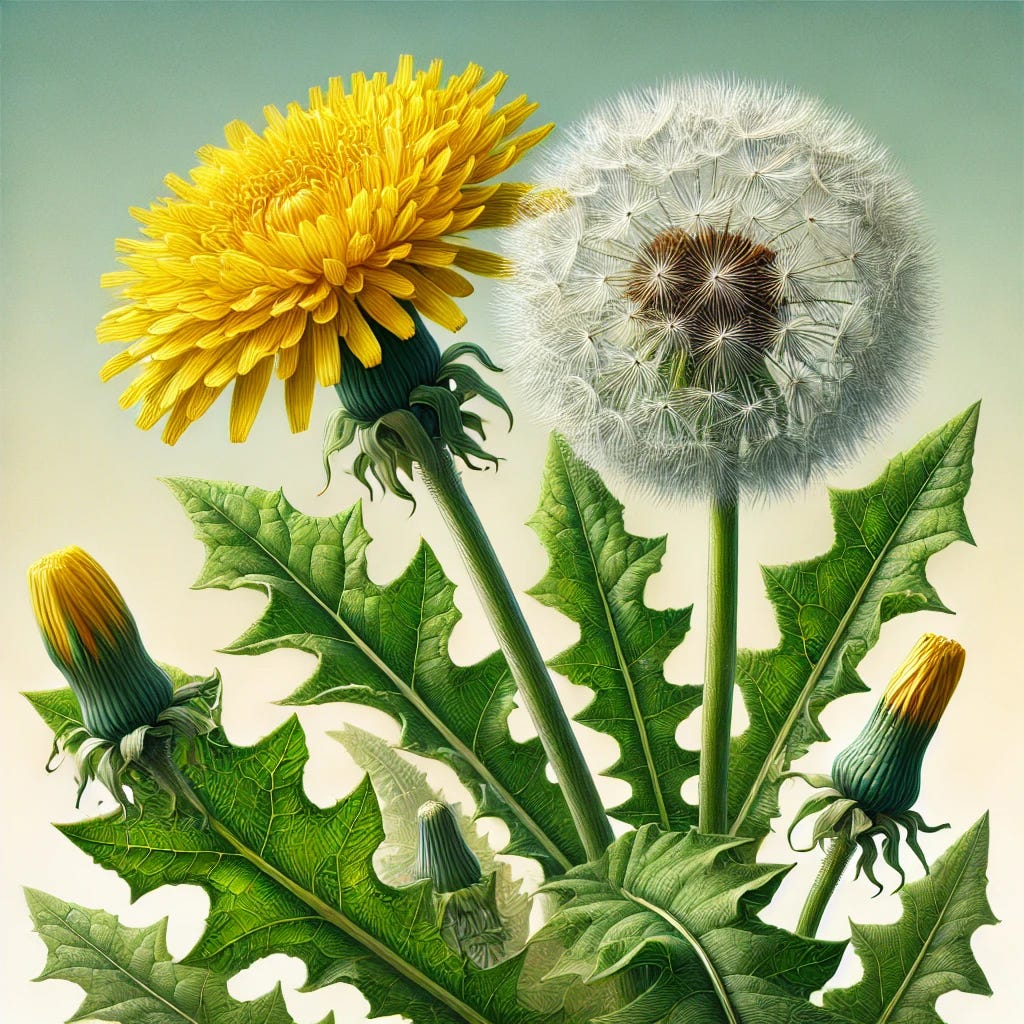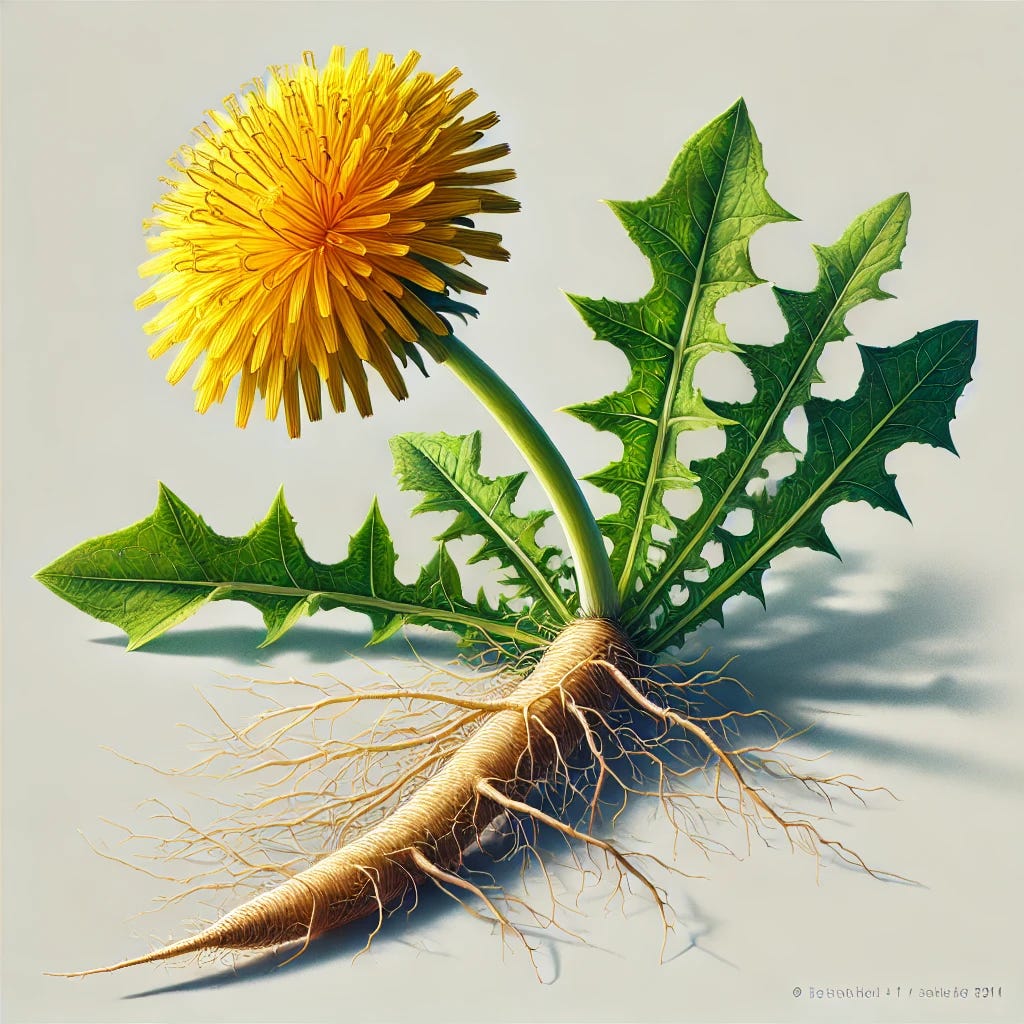Dandelion (Taraxacum officinale): Nature's Radical Regenerator
Contrary to its reputation as a mere lawn nuisance, Taraxacum officinale is a botanical marvel of ecological resilience.
Dandelion (Taraxacum officinale): Nature's Radical Regenerator
Botanical Identity and Origin
Contrary to its reputation as a mere lawn nuisance, Taraxacum officinale is a botanical marvel of ecological resilience. Originally native to Eurasia, dandelions have become a ubiquitous presence across North American landscapes, including the diverse ecosystems of the Okanagan and Pacific West Coast regions [1].
Taxonomic Profile
Family: Asteraceae
Genus: Taraxacum
Species: officinale
Common Names: Common Dandelion, Lion's Tooth (derived from French "dent de lion")

Ecological Architecture: More Than Meets the Eye
Dandelions are sophisticated ecological engineers, far more complex than their unassuming appearance suggests. Their deeply taprooted system—often extending 1-1.5 meters into the soil—serves multiple critical ecological functions:
Soil Decompaction: The robust taproot acts as a natural biological drill, penetrating compacted soil layers, creating channels for water, air, and subsequent root development.
Nutrient Cycling: Through a process called dynamic accumulation, dandelions draw nutrients from deep soil horizons, making them accessible to subsequent plant generations [2].
Mineral Mobilization: The plant's extensive root system actively mines minerals like calcium, potassium, and phosphorus, effectively bringing subterranean nutrients to the surface ecosystem.
Biomimetic Soil Restoration
In degraded or disturbed landscapes of the Okanagan, dandelions function as pioneer species—biological first responders that initiate landscape healing. Their presence signals:
Soil compaction
Mineral deficiencies
Potential pH imbalances
Areas requiring ecological intervention
Regenerative Agricultural Applications
Soil Health Indicators
Dandelions are not invasive competitors but sophisticated ecological diagnosticians. Their presence reveals:
Soil pH between 6.5-7.5
Moderate soil compaction
Potential calcium deficiencies
Areas with good drainage but limited organic matter
Practical Agricultural Interventions
Bioaccumulation Strategies
Use as living mulch in orchards
Integrate into no-till regenerative systems
Utilize as green manure/cover crop
Compost and Fertilizer Production
Entire plant can be used in compost
Leaves provide high nitrogen content
Flowers contribute trace minerals
Roots offer deep mineral extraction capabilities
Companion Planting Dynamics
Dandelions demonstrate remarkable symbiotic potential, particularly when strategically positioned with:
Apple trees
Berry bushes
Root vegetable systems
Disturbed garden perimeters
Medicinal and Nutritional Complexity
Nutritional Profile
Rich in Vitamin A, C, and K
Significant calcium and iron content
Robust antioxidant compounds
Complete protein profile in leaves
Traditional Medicinal Applications
Liver support
Digestive system regulation
Mild diuretic properties
Anti-inflammatory potential
Regional Adaptation: Okanagan and Pacific West Coast Context
In the semi-arid to temperate microclimates of the Okanagan and Pacific West Coast, dandelions demonstrate extraordinary adaptability. They:
Tolerate temperature fluctuations
Require minimal water resources
Thrive in disturbed landscapes
Provide early spring forage for pollinators
Climate Resilience Mechanisms
Deep taproot enables drought resistance
Rapid seed production strategy
Minimal soil nutrient requirements
Extensive genetic variability

Sustainable Harvesting and Management
Ethical Collection Protocols
Harvest from unpolluted areas
Use entire plant when possible
Allow seed dispersal for ecological continuity
Rotate harvest locations
Population Management
Avoid complete eradication
Understand ecological signaling role
Integrate strategic control methods
Conclusion: Reframing Botanical Perception
Dandelions represent more than a botanical curiosity—they are living proof of nature's regenerative intelligence. By shifting from eradication to strategic management, we transform these plants from perceived nuisances to critical ecological partners.
References
[1] Linders, T. E. W., et al. (2019). "Ecological restoration of terrestrial ecosystems in the Anthropocene." Restoration Ecology, 27(5), 929-935.
[2] Altieri, M. A. (2018). Agroecology: The Science of Sustainable Agriculture. CRC Press.
[3] Kimmerer, R. W. (2013). Braiding Sweetgrass: Indigenous Wisdom, Scientific Knowledge, and the Teachings of Plants. Milkweed Editions.






What an amazing plant. Thank you so much for pointing this out! Compost that contains a statistically significant amount of the whole dandelion is nutritionally out of this world.